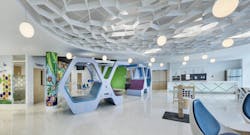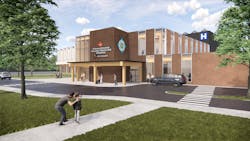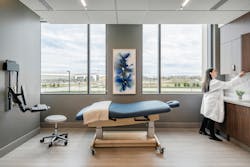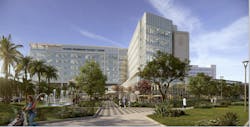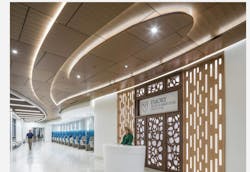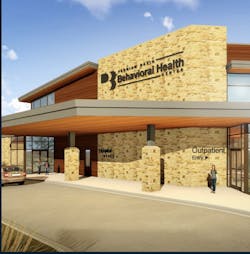Resilient by design: Advancing sustainability in healthcare construction
Sustainability has long been a priority in healthcare construction, but resiliency has become equally essential as climate risks intensify, energy costs rise, and operational demands grow more complex. Today’s healthcare facilities must go beyond meeting green building standards. They need to maintain operations during emergencies, adapt to shifting conditions, and support human health every day.
In response, architects, engineers, and contractors are embracing performance-driven strategies that emphasize durability, flexibility, and occupant safety. Project teams are advancing integrated approaches that address materials selection, indoor environmental quality, decarbonization, and life-cycle analysis—all without compromising patient care or budget constraints.
This course examines how healthcare design and construction professionals are redefining what it means to build sustainably. It highlights real-world strategies for selecting resilient assemblies, enhancing wellness, reducing carbon emissions, and evaluating the long-term value of sustainability investments.
As healthcare organizations focus on long-term operational performance, building product choices and envelope strategies have become increasingly critical. Sustainable healthcare facilities must balance infection control and durability requirements with goals for carbon reduction, energy efficiency, and occupant wellness.
Jeff Mosher, Associate Health Principal at HDR, emphasizes that sustainability in healthcare design must begin with foundational strategies that influence both performance and cost. One example, he explains, is “investing in the building envelope to downsize mechanical systems.” He adds, “Green infrastructure such as green roofs or low-impact site features can eliminate the need for or reduce the size of costly underground storm cisterns.” These approaches reduce mechanical loads, lower life-cycle costs, and support both carbon reduction and wellness goals from the outset.
Mass timber, as demonstrated in the Quinte Health Prince Edward County Memorial Hospital project, presents a major opportunity to reduce embodied carbon while enhancing indoor environments through natural materials and biophilic design.
Randy Keiser, Senior Vice President leading the Healthcare group at Turner Construction, reports that his teams are increasingly focused on sourcing low-carbon materials and minimizing waste from the earliest stages of development. At JE Dunn, Environmental Product Declarations (EPDs) and Health Product Declarations (HPDs) are used to track material performance and transparency, supporting waste diversion rates of 75–85%. The 2025 State of Healthcare Construction Report from Robins & Morton reinforces that clients are now seeking greater accountability around product sourcing, emissions, and reuse.
This broader push for transparency and carbon reduction mirrors the goals of the AIA 2030 Commitment, which urges architects to reduce both operational and embodied carbon through performance modeling and responsible material selection across all project types, including healthcare.
Project teams are increasingly using modeling tools to guide specification decisions and meet performance goals from the earliest phases. HDR leverages platforms like Cove.Tool and OneClick LCA to compare energy use and embodied carbon impacts. CannonDesign and IMEG rely on energy and daylight simulation tools to refine envelope strategies and thermal zoning, reducing loads and improving comfort. CannonDesign also highlights the value of sustainability visioning workshops during planning, where teams set clear targets for energy, water, materials, and resiliency. In one recent project, these sessions shaped a strategy that integrated LEED, WELL, RELi, and Passive House frameworks.
Health and Wellness Design Factors
The connection between the built environment and human health is foundational in healthcare design. Today’s facilities are building on that principle by more deliberately integrating wellness-focused strategies throughout the care environment. Priorities such as daylighting, acoustic comfort, indoor air quality, and thermal regulation are being addressed not only to support healing, but also to reduce stress and improve outcomes for patients, staff, and visitors.
Mosher of HDR emphasizes the impact of early planning decisions, such as optimal building orientation and massing, to maximize natural light while minimizing glare and thermal discomfort. Additional strategies like thermal comfort modeling and advanced air distribution help fine-tune indoor conditions to promote both patient recovery and staff well-being.
One example is UW Health’s Eastpark Medical Center in Madison, Wis., where IMEG implemented a wide range of measures to enhance indoor environmental quality. The 469,000-sf ambulatory care facility includes daylight-optimized spaces, radiant in-floor heating, and smart building systems that support occupant comfort and long-term performance.
Sammy Shams, Senior Design Professional at HKS, notes that giving patients and staff greater control over their surroundings—such as adjustable lighting and temperature—can significantly lower stress and foster a stronger sense of comfort and autonomy. These same priorities shaped the design of the Emory Executive Park Musculoskeletal Institute in Atlanta, a specialty outpatient facility designed by HKS. The project prioritizes solar orientation, thermally efficient cladding, and envelope performance, while integrating biophilic elements and sensory-conscious finishes to create a calming atmosphere that supports emotional wellness.
Robins & Morton applied similar principles in the Permian Basin Behavioral Health Center in Midland, TX, featured in the firm’s 2025 State of Healthcare Construction Report. The facility incorporates calming color palettes, sensory-sensitive lighting, and biophilic features like covered porches—all selected to reduce stress, promote safety, and support emotional regulation.
Beyond physical comfort, trauma-informed design is playing a growing role in how healthcare spaces are shaped. While not every project uses the label explicitly, many teams are applying its core principles—such as predictability, sensory comfort, and access to private spaces—to improve mental and emotional health outcomes.
At a current hospital project in New York City, CannonDesign applied trauma-informed research led by its Blue Cottage team. Early stakeholder engagement ensured that lived experiences influenced layout decisions and material selections. The firm’s interiors team also developed a biophilic design narrative grounded in natural finishes, views of green space, and sensory cues to reduce anxiety and support emotional resilience.
BD+C has also observed that hospitals are increasingly being designed to minimize re-traumatization, foster emotional healing, and create a stronger sense of safety for patients, families, and staff.
Advanced Green Design: Net-Zero, All-Electric Systems, and Decarbonization
As healthcare projects raise the bar on sustainability, all-electric systems and net-zero readiness have become defining strategies for long-term performance and emissions reduction.
As sustainability goals evolve, healthcare organizations are increasingly moving beyond basic energy efficiency to target net-zero emissions and long-term carbon reductions. For design and construction teams, this shift presents both opportunities and challenges in how systems are specified, delivered, and supported across a facility’s lifecycle.
Mosher notes that cost remains a significant barrier to achieving full net-zero outcomes in healthcare settings. As a result, many projects are being designed as “net-zero ready,” enabling future electrification, renewable energy integration, and phased performance upgrades. These strategies allow owners to align long-term sustainability targets with current capital budgets.
IMEG reinforces this position in its published decarbonization guidance, advocating for flexible systems that can adapt as infrastructure and regulations evolve. The firm’s roadmap recommends phased strategies that keep healthcare facilities on track toward carbon neutrality while responding to local grid realities.
Engineering teams are tailoring electrification strategies based on climate, utility rates, and grid capacity. Adam McMillen, Director of Sustainability at IMEG, cautions that fully electric systems may not be appropriate in colder regions with high heating demands or limited access to clean electricity. In such cases, hybrid systems—combining electric and natural gas technologies—can offer a more feasible short-term pathway.
At WSP, April Woods, PE, LEED AP BD+C, Senior Vice President and Building Systems Director, emphasizes that evaluating the carbon intensity of the local utility grid is a critical step in low-carbon design planning. A low-energy-use hospital powered by a fossil fuel–heavy grid may still carry a higher operational carbon footprint than one connected to cleaner sources.
Her colleague, Chris Talbert, PE, LEED AP, CAP, CEM, Senior Vice President and High Performance Building Director at WSP, adds that reaching net-zero in hospital settings requires a holistic approach—one that balances advanced modeling, evolving technologies, and long-term resiliency. “Some of the technologies for energy recovery require refrigerant systems that are not nearly as mature as we would like,” he notes, adding that close collaboration with manufacturers is essential to overcoming these limitations.
Contractors are also helping to lead this shift. Turner Construction’s Keiser reports growing demand for all-electric healthcare projects as owners aim to cut emissions and simplify long-term maintenance. According to JE Dunn, clients increasingly request net-zero readiness as a baseline project requirement, reflecting rising industry expectations around decarbonization.
Decarbonization Strategies and Global Benchmarks
CannonDesign’s Yasha Ogg agrees that while all-electric and net-zero-ready goals are gaining traction, hospital projects remain uniquely complex. Barriers include 24/7 operations, strict ventilation and infection control standards, and site constraints—especially in dense urban areas with limited rooftop solar capacity. Although updates to standards like ASHRAE 170 are helping, many obstacles to healthcare decarbonization persist.
Still, international projects demonstrate that these challenges can be overcome. Ogg points to the Passive House–certified Klinikum Frankfurt Höchst hospital in Germany as a breakthrough example—achieving ultra-low energy use and high-quality patient care in an acute care setting. “It offers a glimpse,” she says, “of what may become more common in the U.S. healthcare sector.”
The 2025 State of Healthcare Construction Report from Robins & Morton highlights the growing role of distributed energy strategies—including microgrids and cogeneration systems—in helping hospitals manage peak loads, boost resilience, and lower carbon intensity.
As BD+C noted in a 2024 article on healthcare trends, “the drive toward electrification and decarbonization is no longer optional—it’s expected.” This growing emphasis on carbon-conscious healthcare design is reshaping not only the systems behind the walls, but also the expectations of clients, regulators, and communities. In many cases, these decarbonization efforts are deeply connected to resiliency goals, as owners seek to ensure continuity of care in the face of climate-related disruptions.
Resiliency Design Strategies
Resiliency in healthcare construction goes beyond emergency preparedness; it’s about ensuring continuity of care under a range of unpredictable conditions. From extreme weather events to long-term climate shifts, healthcare facilities must be equipped to protect occupants, maintain operations, and recover quickly when disruptions occur.
Climate Risk Modeling and Project-Level Mitigation
HDR’s Mosher notes that future-weather modeling and climate risk mapping are increasingly used in project planning to inform site design, massing, and infrastructure decisions. These tools help facilities anticipate long-term climate impacts and optimize performance over time.
IMEG emphasizes that resiliency strategies must be tailored to geographic risks, recommending measures such as floodproofing, elevating mechanical equipment, and enhancing backup systems to ensure operational continuity.
According to Eric Vandenbroucke, Vice President of Healthcare at IMEG, foundational protections are critical: “Without those basics, you may have nothing in the event of an earthquake, flood, tornado, hurricane, etc.” He adds that healthcare clients are increasingly prioritizing hardened structures, redundant utilities, and elevating critical components above flood-prone zones.
WSP also notes that hospitals are being recognized as essential community anchors that must remain operational during and after disasters—reinforcing the need for proactive infrastructure planning.
System Hardening and Infrastructure Adaptation
Keiser and Julianne Laue of JE Dunn Construction both report rising demand for hardened enclosures, flood barriers, and other physical safeguards for mission-critical systems. A notable example is the Ruth Bader Ginsburg Hospital in Coney Island, part of NYC Health + Hospitals, which Turner helped deliver with flood mitigation infrastructure, a fortified exterior designed to withstand hurricane-force winds, and high-efficiency building systems. Designed to remain fully operational during severe weather, the project reflects a forward-thinking approach to care delivery in a changing climate.
Meanwhile, The 2025 State of Healthcare Construction Report from Robins & Morton highlights how clients are treating resiliency as a long-term investment. Strategies include stormwater management improvements, climate-adaptive envelope details, and phased system upgrades that extend facility performance. One example is the Permian Basin Behavioral Health Center project, which supports community resiliency through infrastructure improvements and workforce development partnerships.
The report also notes growing interest in distributed energy strategies, including microgrids and cogeneration. IMEG adds that microgrid systems capable of operating in “island mode” are gaining traction, allowing hospitals to function independently of the grid during extended outages.
Operational Continuity and Long-Term Resiliency Planning
Jackie Mustakas, Senior Sustainability Manager at Robins & Morton, reinforces that resiliency is now an expectation—not a value-add. “Clients are proactively asking how their facilities will perform under stress—not just code-minimum compliance,” she notes, citing the integration of passive survivability, backup power, and phased upgrades to extend operational life.
Shams of HKS emphasizes climate-adaptive strategies such as envelope optimization, natural ventilation, and thoughtful system sizing to reduce reliance on mechanical equipment during prolonged outages. He adds that regional weather trends—like longer, hotter summers—must now influence core performance strategies in both design and construction.
This emphasis on resiliency is echoed by the American Society for Health Care Engineering (ASHE), which has called on healthcare organizations to prepare facilities for “prolonged extreme weather and energy instability” by investing in robust infrastructure and reliable backup systems (ASHE, 2023).
Reducing Operational Costs: HVAC Upgrades and Energy Performance
Mechanical systems represent one of the most significant drivers of energy use in healthcare buildings, making HVAC design a key focus area for reducing operational costs and improving long-term performance.
Heat Recovery and System Efficiency
In healthcare buildings, where HVAC systems run continuously and energy use is high, mechanical efficiency and long-term operational savings remain central to sustainability goals. System selection, integration, and control strategies can significantly affect both energy costs and building resilience over time.
HDR’s Mosher notes that hospitals’ continuous cooling loads make heat recovery essential to performance. “Hospitals’ significant number of 24/7 cooling loads make heat recovery extremely important,” he says. “Advocating for the use of enthalpy wheels and heat recovery chillers in design can lead to significant improvements in energy performance.”
These systems reclaim waste heat and enhance air handling performance, particularly in buildings with high ventilation demands. By reducing dependence on new energy inputs, they also contribute to broader carbon reduction goals.
Smart Controls, Prefabrication, and Maintainability
From an engineering standpoint, IMEG’s McMillen highlights the growing role of smart building automation and advanced fault detection diagnostics. These technologies allow facilities teams to monitor performance in real time, identify inefficiencies, and optimize operations. McMillen notes, however, that “manual system backups remain essential in mission-critical healthcare environments where uptime is non-negotiable.”
His colleague, Vandenbroucke, adds, “Don’t make systems or temporary operations complicated. In a time of panic, the systems need to be simple to operate.”
Turner’s Keiser emphasizes the increased use of prefabricated mechanical systems. These units help streamline installation, improve quality control, and reduce commissioning time—yielding both operational and energy performance benefits.
JE Dunn’s Laue stresses the need to balance energy efficiency with long-term maintainability. “We focus on integrating systems that deliver energy savings without adding unnecessary complexity,” she explains. This includes specifying high-efficiency equipment, incorporating demand response capabilities, and improving envelope performance to reduce HVAC loads.
Resilience, Redundancy, and Passive Design Integration
WSP reinforces the importance of aligning HVAC design with long-term performance and resilience goals. “Systems must be both efficient and dependable, especially during emergencies,” Woods explains. “That means planning for redundancy, ease of maintenance, and the ability to respond dynamically to changing conditions.” Her colleague, Talbert, adds, “Smart system choices up front pay off over time—not just financially, but in operational stability.”
Robins & Morton’s Mustakas notes that HVAC optimization is often where resiliency and sustainability strategies intersect. “By improving envelope performance and prioritizing passive design measures, we reduce the burden on HVAC systems and enhance their reliability during stress events,” she says.
One recent example is the Gloria Drummond Patient Tower and central energy plant at Boca Raton Regional Hospital, where Robins & Morton helped implement energy-efficient systems to support long-term performance. Mustakas emphasizes that early coordination around building systems and performance goals was essential to balancing resiliency and cost-efficiency. The facility integrates advanced HVAC components and on-site energy infrastructure to improve reliability while reducing overall energy demand.
HKS’s Shams agrees that starting with passive design fundamentals is key. “We always look at strategies like solar orientation, building form, and shading before layering on mechanical systems,” he says. “It reduces load, simplifies system design, and lowers long-term operating costs.”
Life-Cycle Assessments and Long-Term ROI Evaluation
As healthcare owners prioritize both sustainability and financial performance, life-cycle cost assessments (LCCA) have become an essential tool for aligning design strategies with long-term value.
As healthcare projects pursue deeper sustainability and resiliency goals, life-cycle cost assessments (LCCA) are playing a larger role in shaping early decision-making. Project teams are looking beyond first costs to evaluate long-term value, carbon impact, and operational efficiency over the full life of a facility.
HDR's Mosher stresses the importance of integrating life-cycle analysis during the earliest phases of design. HDR frequently uses tools like Cove.Tool and OneClick LCA to evaluate energy performance, material impacts, and potential return on investment as strategies evolve during planning. This early modeling allows teams to balance performance goals with real-world budget constraints.
From an engineering perspective, McMillen of IMEG notes that real-time environmental analysis is likely to become standard practice in the near future. “We see LCA becoming much more integrated into the typical workflow,” he says, especially as digital platforms improve the speed and accuracy of comparing product performance, embodied carbon, and cost data.
JE Dunn's Laue says it’s essential to align sustainability strategies with client goals from the outset. “We try to bring lifecycle thinking to the table at project outset—not just because it’s sustainable, but because it supports long-term value for the owner,” she says. Her colleague, Sam O’Connor, Vice President of Healthcare Preconstruction, adds, “We help owners look at where they are making smart investments and where they may be overspending on systems that won’t yield a return. This helps clarify the business case for upgrading the performance of certain MEP systems, particularly in mission-driven facilities like hospitals.”
CannonDesign stresses that early-stage sustainability visioning and energy planning workshops are critical to establishing meaningful performance targets. In one recent New York City hospital project, these sessions helped shape an integrated strategy drawing from multiple frameworks—including LEED, WELL, Passive House, and RELi—to support layered sustainability goals. The firm’s interiors team also developed a robust biophilic design narrative, informed by trauma-informed research led by its Blue Cottage team, while local site tours helped ground performance targets in real-world precedent.
CannonDesign’s Ogg explains, “All this, along with an amazing and innovative design team has pushed the boundary of what is possible within a world class hospital building.”
National Trends in ROI-focused Sustainability
The 2025 State of Healthcare Construction Report from Robins & Morton reinforces this trend, noting that healthcare owners are increasingly using life-cycle cost analysis to evaluate trade-offs between capital investment, resilience, and operational performance.
This shift is also reflected in national outlooks. According to the Associated General Contractors of America (AGC), contractors report that “owners are more frequently asking for lifecycle and sustainability analysis as part of capital planning—not just for certification purposes, but as a way to validate performance and ROI projections.”
Case Studies
The following case studies illustrate how project teams are applying sustainability, resiliency, and wellness strategies in real-world healthcare construction projects.
Quinte Health Prince Edward County
Memorial Hospital
Location: Picton, Ontario, Canada
Firm: HDR
The Quinte Health Prince Edward County Memorial Hospital is the first unencapsulated, all–mass timber acute care hospital in North America, positioning it as a model for low-carbon healthcare construction. Compared to a conventional steel and concrete structure, the facility is projected to eliminate more than two million kilograms of embodied CO2 emissions.
HDR’s integrated approach combines sustainable materials, advanced medical planning, and biophilic design to support both carbon reduction and patient-centered care. Key systems include a high-performance building envelope, geothermal energy exchange, and rooftop photovoltaic arrays. The design also incorporates green roofs, native and Indigenous-inspired landscaping, and composite wood cladding. These strategies help future-proof the facility for electrification and net-zero readiness.
Inside, patient rooms, nursing stations, and corridors feature clean, exposed mass timber ceilings that meet infection control standards while enhancing visual warmth and acoustics. Standardized glazing and zero-edge parapets reveal the timber structure from the exterior, reinforcing the building’s natural aesthetic and promoting occupant connection to nature.
Wellness amenities include a landscaped public garden for patients and visitors and a secluded off-stage garden for staff. Together, these features demonstrate how mass timber and sustainable design strategies can deliver durable, adaptable, and healing-centered environments—even in rural healthcare settings.
UW Health Eastpark Medical Center
Location: Madison, Wis.
Firm: IMEG
UW Health’s Eastpark Medical Center is a 469,000-sf ambulatory care facility that opened in 2024 and is designed with long-term sustainability and operational flexibility in mind. The facility is expected to be one of the first healthcare projects in the U.S. to achieve LEED v4.1 certification, reflecting its high-performance building systems and sustainable engineering strategies.
The center houses the Carbone Cancer Center, home to Wisconsin’s first proton therapy unit—including one of the first upright proton therapy systems in the U.S. A 1MW photovoltaic carport array generates sufficient electricity to support this advanced technology, while heat recovery from the proton system is used for perimeter radiant heating, enabling partial electrification of the facility’s heating systems.
IMEG engineered the building with a strong focus on electrification, resiliency, and decarbonization. Design strategies include heat recovery chillers, radiant in-floor heating, dry coolers to offset winter chilled water load, six high-efficiency hot water boilers, and 13 variable-volume rooftop air handlers delivering 570,000 CFM of air.
Additional infrastructure supports long-term flexibility, including robust process water cooling for proton equipment, radiation-conscious MEP design, and smart systems like electronic power monitoring and nurse call integration. The building is also designed to accommodate integration with three future buildings, supporting growth and modernization.
Emory Executive Park Musculoskeletal Institute
Location: Atlanta
Firm: HKS
The Emory Executive Park Musculoskeletal Institute is a 180,000-sf specialty healthcare facility that delivers integrated musculoskeletal care in a high-performance, patient-centered environment. Designed by HKS in partnership with Emory Healthcare, the facility serves as a national model for outpatient innovation, emphasizing flexibility, sustainability, and wellness.
The project’s sustainability strategy focused on reducing energy demand and enhancing long-term adaptability. Key design measures included optimizing solar orientation and massing, improving envelope performance, and specifying high-performance systems to reduce mechanical loads. Notable features include low-emissivity glazing, exterior sunshades, thermally efficient cladding, and smart lighting systems that reduce reliance on artificial light.
The building also integrates biophilic design elements such as natural materials, public art, and strong visual connections to the outdoors—all aimed at reducing stress and supporting occupant wellness. These strategies reflect HKS’s internal sustainability benchmarks and align with the client’s long-term decarbonization goals.
The project has been showcased at industry conferences as a leading example of performance-based outpatient design, demonstrating how energy-conscious planning and wellness-driven design can be successfully integrated in complex healthcare environments.
Permian Basin Behavioral Health Center
Location: Midland, Texas
Firm: Robins & Morton
Scheduled to open in 2026, the Permian Basin Behavioral Health Center (PBBHC) represents a critical investment in expanding behavioral health services across a historically underserved area of West Texas. Robins & Morton identifies the project as a flagship example of socially resilient infrastructure that extends its impact beyond the built environment.
To address anticipated staffing challenges, project leaders collaborated with local foundations, businesses, and educational institutions to develop behavioral health job training programs. This workforce-focused approach to resiliency helps ensure long-term operational sustainability while creating economic and professional opportunities within the community.
Design strategies emphasize trauma-informed care through calming color palettes, sensory-sensitive lighting, and biophilic elements—including covered porches and outdoor gathering spaces—that promote emotional wellness. According to Bob Wall, Vice President at Robins & Morton, the building “supports healing through thoughtful spatial and sensory planning,” reflecting the contractor’s expanding behavioral health expertise.
Conclusion
Sustainable healthcare construction today goes far beyond energy efficiency or material selection. It demands a broader, integrated approach, one that begins early in the design process and accounts for long-term resiliency, operational performance, and occupant well-being.
By combining performance-based strategies with lifecycle cost analysis, project teams are better equipped to design buildings that support both immediate functional needs and future adaptability. Resiliency planning, whether through climate modeling, elevated infrastructure, or system redundancy, is becoming inseparable from sustainability. At the same time, wellness-centered design strategies, including trauma-responsive approaches, are shaping environments that are not only safer and healthier but also more supportive of the people who use them.
As expectations continue to evolve, healthcare facilities are being redefined as critical infrastructure, places that must withstand disruption, foster healing, and serve their communities long into the future. For architects, engineers, and contractors alike, this shift presents both a challenge and an opportunity: to design with care, plan for uncertainty, and deliver healthcare buildings that are truly resilient by design.
To earn one American Institute of Architects Continuing Education System Learning Unit of Health, Safety, Welfare credit (1 LU HSW), read “Resilient by design: Advancing sustainability in healthcare construction.” Then review the exam below and enter your answers at: BDCnetwork.com/HealthcareCourse2025.
